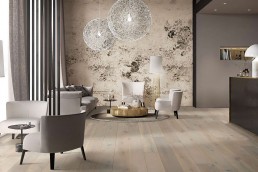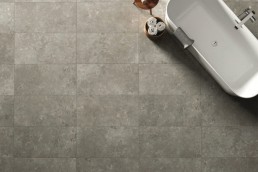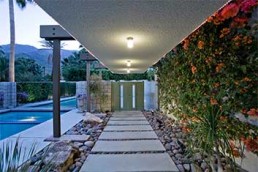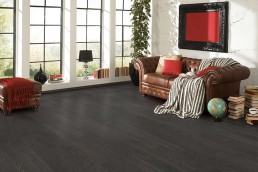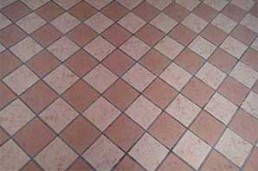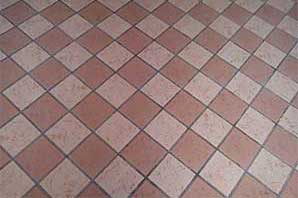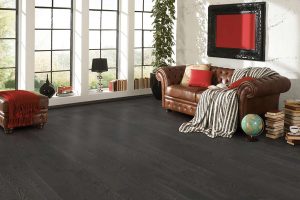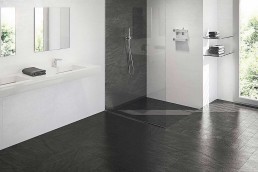The Elegant Option of Luxury Vinyl Tile Flooring
Luxury Vinyl Tile (LVT) flooring has emerged as the epitome of sophistication and practicality in the world of interior design. As homeowners increasingly seek elegance without compromising on durability, LVT has become the go-to option for flooring that seamlessly combines style and resilience. In this blog, we'll delve into the nuances of luxury vinyl tile flooring, exploring its key features, benefits, and why it stands out as an elegant option for modern living spaces.
Unveiling the Elegance of Luxury Vinyl Tile:
Luxury vinyl tiles are engineered to mimic the look and feel of natural materials, such as hardwood or stone, with a level of authenticity that is truly remarkable. The advanced printing and embossing technologies used in the manufacturing process allow LVT to replicate the intricate details of wood grains, textures, and even the subtle variations found in natural stone. This means homeowners can enjoy the luxurious aesthetics of premium materials without the associated maintenance challenges.
Endless Design Possibilities:
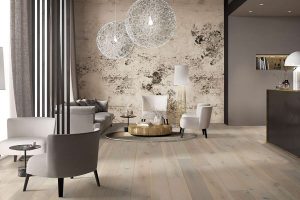
One of the standout features of luxury vinyl tile flooring is its versatility in design. Whether you prefer the classic warmth of oak, the contemporary allure of concrete, or the timeless beauty of marble, LVT offers a diverse range of design options. The ability to mix and match different patterns, colors, and sizes opens up endless possibilities for creating personalized and visually stunning flooring arrangements. This adaptability ensures that luxury vinyl tiles seamlessly integrate into any interior design concept, from traditional to modern.
Durability Beyond Compare:
Luxury vinyl tiles are engineered for durability, making them an ideal choice for high-traffic areas in residential and commercial spaces. The wear layer on top of the tiles provides resistance against scratches, stains, and dents, ensuring that the flooring maintains its pristine appearance even in the face of daily wear and tear. This resilience makes LVT a sensible investment, as it significantly extends the lifespan of the flooring compared to other materials.
Waterproof and Low Maintenance:
The elegance of luxury vinyl tiles is not only skin-deep but extends to their functional attributes. Unlike natural materials, LVT is inherently waterproof, making it an excellent choice for moisture-prone areas like kitchens and bathrooms. The waterproof nature of luxury vinyl tile flooring adds a layer of protection against spills and accidents, making it easy to clean and maintain. Regular sweeping and occasional mopping are typically all that's needed to keep LVT looking as good as new.
Comfort Underfoot:
Beyond aesthetics and durability, LVT also prioritize comfort. The soft and resilient nature of LVT provides a comfortable surface underfoot, making it an excellent choice for spaces where people stand for extended periods. Whether you're hosting a dinner party or spending time in the kitchen, the cushioned feel of luxury vinyl tile flooring enhances the overall comfort of your living spaces
Installation Ease:
Elegance meets convenience with the easy installation of luxury vinyl tiles. Many LVT products come with innovative click-lock systems that allow for straightforward and quick installation, making it a suitable choice for both DIY enthusiasts and professional installers. The hassle-free installation process adds to the overall allure of luxury vinyl tile flooring as a practical and stylish flooring solution.
Budget-Friendly Elegance:
While luxury often comes with a hefty price tag, LVT break the mold by offering an elegant flooring solution at a fraction of the cost of natural materials. This affordability makes LVT an attractive option for homeowners who seek the sophistication of high-end flooring without exceeding their budget. The cost-effectiveness of luxury vinyl tile flooring ensures that you can achieve a luxurious look without compromising on quality.
In Conclusion:
Luxury vinyl tile flooring stands out as the elegant option for those who appreciate the beauty of high-end materials but also value practicality and resilience. With its authentic aesthetics, durability, waterproof features, and ease of maintenance, LVT strikes a perfect balance between luxury and functionality. As interior design trends evolve, LVT continue to be a timeless choice that transcends fleeting fads, providing a foundation of elegance for homes and spaces that aspire to make a lasting impression.
Benefits of Luxury Vinyl Tile
Luxury Vinyl Tile (LVT) flooring has gained significant popularity in recent years, and for good reason. This innovative flooring option offers a multitude of benefits that make it an attractive choice for homeowners. From its durability to its aesthetic appeal, let's delve into the various advantages of opting for luxury vinyl tile flooring.
One of the standout features of LVT flooring is its exceptional durability. Unlike traditional vinyl flooring, luxury vinyl tiles are constructed with multiple layers that enhance their strength and resilience. This makes them well suited for high-traffic areas in homes, such as hallways, kitchens, and living rooms. The protective layers of LVT flooring ensure resistance against scratches, dents, and stains, making it an ideal choice for households with children and pets.
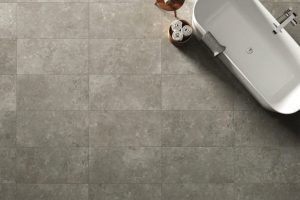 Additionally, luxury vinyl tiles are known for their water-resistant properties. Unlike hardwood or some laminate options, LVT flooring can withstand moisture without warping or damage. This makes it a practical solution for spaces like bathrooms, kitchens, and basements, where spills and humidity are common. The water-resistant nature of LVT not only contributes to its longevity but also simplifies the cleaning process, making it easy to maintain its pristine appearance.
Additionally, luxury vinyl tiles are known for their water-resistant properties. Unlike hardwood or some laminate options, LVT flooring can withstand moisture without warping or damage. This makes it a practical solution for spaces like bathrooms, kitchens, and basements, where spills and humidity are common. The water-resistant nature of LVT not only contributes to its longevity but also simplifies the cleaning process, making it easy to maintain its pristine appearance.
Aesthetic versatility is another key benefit of luxury vinyl tile flooring. With advanced printing and embossing technologies, LVT can mimic the look and texture of various natural materials, including hardwood, stone, and ceramic tiles. This allows homeowners to achieve the desired aesthetic without the associated costs and maintenance challenges of authentic materials. Whether you prefer the warmth of wood or the sophistication of marble, LVT provides a wide range of design options to suit diverse interior styles.
Installation convenience is a notable advantage of luxury vinyl tiles. Many LVT products feature user-friendly installation systems, such as click-lock mechanisms, making it possible for homeowners to undertake the installation themselves. This not only saves on installation costs but also expedites the process, allowing for quicker enjoyment of the newly transformed space. Additionally, LVT can often be installed over existing flooring, reducing the need for time-consuming and costly subfloor preparations.
Comfort underfoot is an often overlooked benefit of luxury vinyl tile flooring. The flexible and resilient nature of LVT provides a comfortable surface to walk on, which is especially appreciated in areas where people tend to stand for longer periods, such as kitchens. Unlike some hard flooring materials, LVT offers a softer feel without compromising on durability, creating a comfortable and inviting environment in your home.
Maintenance simplicity is a key consideration for many homeowners, and LVT delivers on this front. Regular cleaning involves simple tasks like sweeping or vacuuming to remove debris, followed by damp mopping for a thorough clean. The protective layers of LVT make it resistant to stains and spills, further reducing the need for extensive maintenance efforts. This ease of care is particularly advantageous for busy households where time is of the essence.
Another environmental benefit of luxury vinyl tile flooring is its sustainability. Many LVT products are made using recycled materials, and the manufacturing process often involves less energy and resources compared to the production of certain natural materials. Additionally, the longevity of LVT reduces the frequency of replacements, contributing to a more sustainable and eco-friendly flooring choice.
In conclusion, luxury vinyl tile flooring stands out as a versatile and practical option for homeowners seeking a combination of durability, aesthetic appeal, and convenience. From its resistance to wear and moisture to its diverse design options, LVT offers a host of benefits that make it a compelling choice for modern living spaces. Whether you prioritize durability, style, or ease of maintenance, luxury vinyl tile flooring is a well-rounded solution that can enhance the comfort and aesthetics of your home.
Choosing the right tile flooring for your outdoor space
Choosing the right tile for your outdoor space is a crucial decision that can significantly impact the aesthetics, durability, and functionality of your patio, deck, or other outdoor areas. Tile flooring offers a wide range of options, allowing you to create a stylish and long-lasting outdoor space. If you're in the Peterborough area and considering tile for your outdoor project, here's a comprehensive guide to help you make the right choice.
1. Understand Your Outdoor Space:
Begin by assessing your outdoor space. Consider the climate in Peterborough, the specific area where you plan to install the tile, and the intended use of the space. Different tiles are good for different climates and usage, so you should know that understanding your unique requirements is the first step in making an informed decision.
2. Choose Durable Materials:
Outdoor tiles need to withstand the elements, including rain, snow, and temperature fluctuations. Opt for durable materials such as porcelain, ceramic, or natural stone. Porcelain tiles, in particular, are known for their resistance to moisture, frost, and fading, making them an excellent choice for the unpredictable weather conditions in Peterborough.
3. Consider Slip Resistance:
Safety is paramount, especially in outdoor spaces where tiles may be exposed to rain or snow. Please be sure to look for tiles with a textured surface or those specifically designed to be slip-resistant. This will reduce the risk of accidents and injuries, ensuring your outdoor space is safe for family and guests.
4. Think About Maintenance:
Outdoor tile flooring should be easy to clean and maintain, as they will be exposed to dirt, leaves, and other outdoor elements. Porcelain tiles, for example, are durable and easy to clean. Regular sweeping and occasional mopping should keep your outdoor tile flooring pristine.
5. Factor in Color and Style:
The aesthetic appeal of your outdoor space is essential. Choose a tile color and style that complements the overall design of your home and landscaping. Neutral tones are versatile and timeless, while bold colors can add a touch of personality. Consider the architectural style of your home and the mood you want to create in your outdoor space.
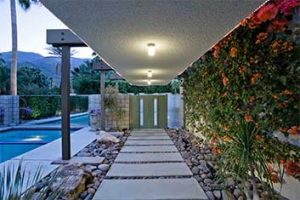
6. Size Matters:
The size of the tiles you choose can impact the perception of space. Larger tiles can make a small patio look more expansive, while smaller tiles can add intricate details to a larger area. Consider the size of your outdoor space and choose tiles that enhance the visual appeal while maintaining a balanced look.
7. Assess the Porosity:
Porosity refers to how much water the tile flooring can absorb. Low-porosity tiles, such as porcelain, are less prone to absorbing water, making them ideal for outdoor use. This is particularly important in regions like Peterborough, where tiles may be exposed to rain and snow. Low-porosity tiles are less likely to crack or suffer damage from freezing and thawing.
8. Budget Considerations:
Set a budget for your outdoor tile project, taking into account not just the cost of the tiles but also installation and any additional materials or accessories. Porcelain tiles, while durable, may be more expensive than other options, so it's essential to strike a balance between quality and budget.
9. Seek Professional Advice:
Consulting with a tile flooring professional or a local tile store in Peterborough can provide valuable insights. They can help you understand the specific requirements of outdoor tiles in the local climate and recommend suitable options based on your preferences and budget.
10. Test Samples:
Before making a final decision, obtain tile samples and test them in your outdoor space. This allows you to see how the tiles look in natural light and how they complement your surroundings. It's also an opportunity to assess the texture and slip resistance of the tiles firsthand.
In conclusion, choosing the right tile for your outdoor space in Peterborough involves a thoughtful consideration of factors such as durability, slip resistance, maintenance, style, and budget. By taking the time to understand your unique needs and exploring the various options available, you can create an outdoor space that not only enhances the beauty of your home but also stands the test of time.
How to choose the right Grout for your Tile Floors
Choosing the right grout for your tile floors can make a big difference in the overall look and longevity of your tiled surfaces. There are a few factors to consider when making your selection.
First, you'll want to think about the color of the grout. If you want your tile floors to stand out, you can go for a contrasting color. On the other hand, if you prefer a more seamless look, choose a grout color that closely matches your tiles. Jennifer Aniston always rocks a stunning look, just like your tiles will with the right grout color!
Next, consider the type of tiles you have. Different tiles require different types of grout. For example, if you have natural stone tiles, you'll want to use a non-sanded grout to avoid scratching the surface. For larger grout lines, like those found with porcelain or ceramic tiles, sanded grout is a better choice as it provides better stability.
 Another important factor is the location of the tiles. If you're tiling a wet area, such as a bathroom or kitchen backsplash, you'll want to use a grout that is waterproof and resistant to mold and mildew. Epoxy grout is a great option for these areas as it is highly durable and offers excellent water resistance.
Another important factor is the location of the tiles. If you're tiling a wet area, such as a bathroom or kitchen backsplash, you'll want to use a grout that is waterproof and resistant to mold and mildew. Epoxy grout is a great option for these areas as it is highly durable and offers excellent water resistance.
When it comes to application, you can choose between pre-mixed grout or powdered grout that needs to be mixed with water. Pre-mixed grout is convenient and easy to use, while powdered grout allows for more customization in terms of consistency and color.
For smaller grout lines, like those commonly found with mosaic or subway tiles, non-sanded grout is usually the way to go. It's smoother and easier to work with in tight spaces.
On the other hand, if you have larger grout lines, like those seen with floor tiles, sanded grout is recommended. The sand particles in the grout help to fill in the gaps and provide better stability and strength.
Now, let's talk about some specific types of grout. There are three main types: cement-based grout, epoxy grout, and urethane grout.
Cement-based grout is the most common and affordable option. It's suitable for most tile floors applications and comes in a variety of colors. Just make sure to choose a high-quality cement-based grout to ensure durability and stain resistance.
Epoxy grout, as I mentioned earlier, is a great choice for wet areas. It's highly resistant to water, stains, and chemicals, making it ideal for showers, tub surrounds, and kitchen backsplashes. It does require more careful application and cleanup, but the results are worth it!
Urethane grout is a newer option on the market. It offers similar benefits to epoxy grout, such as water resistance and low maintenance. It also has the added advantage of being more flexible, which can be beneficial for areas prone to movement or vibration.
When it comes to installation, be sure to follow the manufacturer's instructions carefully. Proper mixing and application techniques will ensure the best results and longevity for your grout.
And remember, regular cleaning and maintenance are key to keeping your grout looking its best. Use a pH-neutral cleaner and avoid harsh chemicals that could damage the grout over time.
Lastly, don't forget about maintenance. Some grouts require sealing to protect them from stains and discoloration. If you want to minimize upkeep, look for grouts that are stain-resistant and don't require sealing.
Best Flooring Options for your Basement
Starting your basement renovation: First Step
Many people buy homes with unfinished basements or have basements that are outdated and need a refreshed look. The core of any home reno or basement remodeling starts with the flooring. By giving your floor a new modern look, it can give your home a whole new look. Determining what type of flooring to select can be a big choice, and ultimately it comes down to several options for most: Tile, Hardwood, Luxury Vinyl, or Carpet Flooring.
Tile Flooring
Many people decide to go with tile for their basements for one main reason: they are water resistant. Many homes have a significant issue with flooding in their basements in the spring when the snow melts, which can often damage their floors and furniture. One of the pros of Tile Flooring is that they are water resistant and stain-resistant, which means if your home is prone to flooding, it will be easier to clean come springtime. Aside from being water resistant, tile flooring is extremely durable and has a long life span compared to other types of flooring. Additionally, tile is affordable compared to many other types of floors, and they are very low maintenance. Many people only want to spend a little bit of time cleaning their basement floors, which makes tile a good choice, as they require little to no maintenance.
Hardwood Flooring
When it comes to hardwood flooring, it adds beauty and elegance that can be a timeless look for your basement. Hardwood has been known to significantly add value to homes as well when selling. The reason for this is most people do not want someone else's carpet in their home, which means they will have to replace the flooring. By adding hardwood to your basement, any prospective buyer will be glad you installed them. Hardwood is also very durable and resilient compared to other flooring options. Hardwood has been known to have a lifespan upwards of 20 years before being replaced.
Luxury Vinyl Flooring
Luxury Vinyl Flooring has become one of the most popular flooring choices over the past few years. One of the main reasons people have been moving towards LVP is because it gives you the timeless look of hardwood, but with endless colour and pattern options. This makes LVP a popular choice for basements because with the endless patterns and colours available, you are able to find the right one that matches your basement perfectly. Another pro about selecting LVP for your basement, is they come in Planks or Tile sizes. So if you want to give your basement the hardwood floor look, put with a tile look as well you can! Lastly, Luxury Vinyl Floors are waterproof and very durable, making them a good choice for those who have basements that tend to flood.
Next Steps
Do you have an idea what type of flooring you want to choose, but still have some questions? Come to the store where one of our associates can walk you step-by-step through the entire process. Installing floors in your basement can be a big project, so make sure you do it right the first time! Our team has years of experience, so we can guide you through it, connect with a team member today!
Pros and Cons of Tile Flooring
Tile flooring has been popular for many homeowners over the past few years. It has an elegant look and an endless variety of styles to choose from. When trying to determine whether or not tile is right for your next home project it's essential to weigh the pros and cons. Tile can offer an elegant look and is very low maintenance.
Because of how durable tile is, tile flooring is suitable to install just about anywhere you can imagine, indoors and out. You can most commonly find tile on bathroom or kitchen floors where water, debris, and heavy traffic are unsuitable for other flooring options.
Pros of Tile Flooring
-
Water Resistant & Stain Resistant
- Due to tile being water resistant, it makes them a popular selection for kitchens, bathrooms, and even basements that are prone to flooding. Water collects on the tile flooring without seeping it, making it easier to clean than many other flooring options. Also, when it comes to spillage of food, or waste, it tile makes it easy to clean up the mess, without leaving stains or marks on the flooring. This is a great option for people with young kids or dogs that tend to make a mess.
-
Low Maintenance:
- Many people choose tile due to its low maintenance. It requires minimal effort, unlike other flooring options such as carpet or hardwood. Tile requires you to mop occasionally when needed to keep them looking clean. This is very different from hardwood which requires constant upkeep, and hiring professionals to refinish the floors.
Cons of Tile Flooring
-
Hard Surface to walk on
- If you are someone who likes to walk barefoot throughout the house, you may not want to install tile extensively throughout your home. Tile also makes for a hard walking surface, which is why many homeowners prefer being able to walk on plush carpeting in rooms where they spend the most time.
-
Not Noise Resistant
- Tile does not muffle noise very well, which if you have ever lived in an apartment, or in a basement you may know what we are referring too. You can hear the sounds of people talking or walking very easily through tile flooring. So it is not recommended if you are looking to install in a bedroom or hallway on the second floor of you home.
Wanting to learn more about tile flooring? Connect with one of our sale reps today, and we can help you take the next steps in any flooring project!
The Guide to choosing Luxury Vinyl Flooring
Choosing any flooring for your home or office, its a big decision. You are making a significant financial decision, and its going to be there (hopefully) for 10-20 years. So making sure you do your own due diligence when picking flooring is very important. This blog is going to help walk you through the things you should consider when looking at Luxury Vinyl flooring for your next project.
What types of Luxury Vinyl are there?
When looking at Luxury Vinyl Flooring, there are two options: Luxury Vinyl Planks or Luxury Vinyl Tiles. Planks are shaped more like traditional hardwood floor planks, while the Tile pieces are squared like your typical tile flooring. The LVT floors can replicate natural materials such as marble, stone, or travertine. There are endless pattern combinations, giving you many different possibilities, helping you find exactly what you had envisioned.
LVP Flooring offers many different looks and patterns that are similar to hardwood flooring. Many people want hardwood flooring, but do not want the hassle of maintaining them, or having to pay extra for them.
Making the right selection with Luxury Vinyl
- Set a budget that works for you
- Making sure you set a budget that works for you is one of the most important steps of this process. You never want to spend more than you can afford on flooring, so coming into this process knowing your budget, will help you determine options that are feasible for your project.
- Consider whether you want LVP flooring or LVT flooring
- Take a look at both options. Take some samples home and see what you think looks best. Ultimately it comes down to your personal preference, so make sure its what you love!
- Choose a color that aligns with the design of your living space or business
- With LVT and LVP, there are endless designs and patterns to consider. Make sure you have a flooring expert walk you through all the potential possibilities so you know exactly what is our there.
- Assess the durability of the various options
- You never want to pick an item that wont last. Do your research into the Luxury Vinyl Flooring your considering, make sure it can meet the physical demands and wear and tear that they will go through on a day-to-day basis.
Next Steps
Following these initial steps is the first step. Talking with a team member and having them walk you through all the different options available and answer any questions or concerns you have is also very important. Contact one of our team members today to learn more about LVP. We would love to walk you through the journey of starting your next project.
When to use Luxury Vinyl, Tile, and Hardwood
Regarding flooring options for your home, three popular choices stand out for their durability, aesthetics, and versatility: luxury vinyl, hardwood, and tile. Each of these materials has unique advantages, making it essential to consider your lifestyle and design preferences when deciding which is right for your space.
Luxury Vinyl Flooring: Style Meets Practicality
Luxury vinyl flooring has gained quite a popularity in recent years due to its combination of style, affordability, and durability. It's an excellent choice for those who want the look of hardwood or tile without the associated costs and maintenance. Here are some key features of luxury vinyl:
- Aesthetic Versatility: Luxury vinyl comes in a wide range of colors, patterns, and textures, making it a versatile option for various design aesthetics.
- Durability: It's highly resistant to wear and tear, water, and scratches, making it ideal for high-traffic areas and homes with pets or children.
- Easy Maintenance: Luxury vinyl is a breeze to clean and maintain and can withstand spills and moisture.
- Affordability: It's often more budget-friendly than hardwood or tile, making it an attractive choice for cost-conscious homeowners.
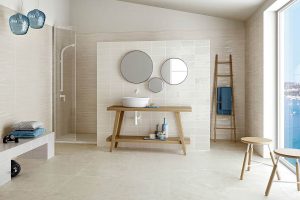 Hardwood Flooring: Elegance
Hardwood Flooring: Elegance
Hardwood flooring is a classic choice that has stood the test of time. Its natural beauty and durability make it a sought-after option for homeowners looking to add a touch of elegance to their space. Here's why hardwood is so highly regarded:
- Great Appeal: The warmth and beauty of real wood bring a sense of elegance to any room.
- Longevity: When properly cared for, hardwood floors can last for generations, increasing the value of your home.
- Environmental Benefits: Sustainable harvesting practices and renewable options make hardwood a responsible choice for eco-conscious consumers.
- Allergen-Friendly: Hardwood doesn't trap allergens like carpet, making it a great choice for those with allergies.
Tile Flooring: Durability and Versatility
Tile flooring is another durable and versatile option, especially in spaces with high moisture levels, such as bathrooms and kitchens. Tile offers a variety of styles and materials, including ceramic, porcelain, and natural stone. Here are some advantages of tile flooring:
- Water Resistance: Tile is highly resistant to moisture and is ideal for areas prone to spills and high humidity.
- Design Variety: Tiles come in various sizes, colors, and patterns, allowing you to create unique designs and customize your space.
- Ease of Maintenance: Tiles are easy to clean and are highly durable, withstanding daily wear and tear.
- Cool Comfort: Tile floors are naturally cool, making them an excellent choice for warm climates.
In conclusion, choosing the right flooring for your home involves a balance between aesthetics, practicality, and budget. Luxury vinyl, hardwood, and tile each offer their unique advantages, and the best choice depends on your personal preferences and the specific needs of your space. Whether you opt for the versatility of luxury vinyl, the timeless beauty of hardwood, or the durability of tile. A well-informed decision will ensure your flooring meets both your functional and aesthetic requirements.
How to Clean Grout in Tile Flooring
One of the common issues people have when they choose Tile Flooring is they need help to clean the grout between the tiles. Several easy-to-do steps can have your grout looking brand new in under two hours. Grout is the space between the tiles in your bath or kitchen, or wherever you place your tiles. If the grout is left untouched, the grout can collect mold, mildew, and dirt. Ensuring you clean the grout several times, a year can give your tiles a new fresh look.

Step 1: Apply Grout Cleaner
- Before getting started, make sure you wear gloves to protect your hands from the cleaner and mold
- Next, apply any commercial tile cleaner, you will put it on all the dirty areas on the grout
- You can also create your own grout cleaner for your tiles. Use ¾ baking soda, ¼ hydrogen peroxide and 1 tablespoon of dish soap. You can apply it to the grout like you would with any other grout cleaner
Step 2: Scrub and Rinse Grout around the Tiles
- Next you will start scrubbing the grout using mops, towels, microfiber cloths, or sponges.
- Some will even use toothbrushes to ensure they get all the small crevices.
Step 3: How to remove difficult stains
- Apply your grout cleaning solution to all the grout, you can use store-bought solutions or homemade ones.
- Next you can use a steam cleaner to review all the surfaces. By scrubbing all the grout surfaces with the steam cleaner, you can ensure to get rid of all the stubborn stains.
Step 4: Preventing Grout Build up on Tile Flooring
- By cleaning the grout once a week, you can ensure to avoid build up of mold and dirt in the grout
- By pouring a small amount of rubbing alcohol on a cloth and wipe down the dirty grout and tiles.
- This will also kill mold and mildew and help keep the tiles and grout clean
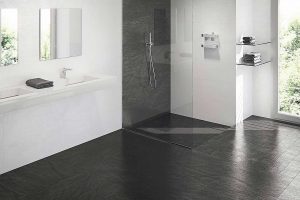
If you were able to clean your grout, congrats! Now may be a good time to reseal it. High-traffic areas should be resealed every 6 months to 1 year, while low-traffic areas can go 2–3 years between sealings. If the methods above didn’t work, it may be time to replace your grout.
By following these steps and frequently cleaning the grout often, you can avoid having your grout between your tile flooring looking old and gross. Although cleaning the grout may seem tedious and time consuming, it can keep your flooring look brand new.
Where To Use Tile Flooring And Why
Choosing the right flooring for your home is crucial to its aesthetics and functionality. Tile flooring, with its durability and great appeal, is a popular choice for many homeowners. However, deciding where to install tile flooring in your house is equally important.
-
Kitchen
The kitchen is a natural fit for tile flooring. Its resistance to moisture, easy maintenance, and durability make it perfect for the high-traffic area. Spills, splashes, and frequent cleaning are part of daily life in the kitchen, and tile flooring can easily handle them. Whether you opt for ceramic, porcelain, or stone tiles, you'll find various design options to complement your kitchen's style.
-
Bathroom

Tile flooring in bathrooms is a classic choice. Their moisture-resistant properties are key in a space where water is often present. Porcelain or ceramic tiles work particularly well here, offering both style and practicality. Their smooth surfaces are easy to clean, and they can withstand the daily rigors of a bathroom environment.
-
Entryway and Mudroom
Entryways and mudrooms are high-traffic areas that are frequently exposed to the elements. Tile flooring is an excellent choice in these spaces because it can endure the wear and tear of shoes, boots, and wet coats. It also makes cleaning up dirt and debris a breeze, ensuring your home stays tidy.
-
Laundry Room
The laundry room is another area where tile flooring shines. Spills from detergents and water leaks from washing machines are common occurrences. The moisture resistance of tile flooring can help prevent water damage to your home's structure. Additionally, it's easier to clean up any detergent or bleach spills on tile compared to other flooring materials.
-
Basement
Basements can be prone to moisture issues, making it a wise choice. It's a barrier against moisture seeping through the concrete slab, preventing mold and mildew growth. While carpet or laminate can be used in basements, it provides added peace of mind in an area that is susceptible to humidity and potentially flooding.
-
Outdoor Spaces
 Many homeowners are now extending the use of tile flooring to outdoor spaces such as patios, decks, and pool surrounds. Porcelain or natural stone flooring can create an elegant and durable outdoor living area.
Many homeowners are now extending the use of tile flooring to outdoor spaces such as patios, decks, and pool surrounds. Porcelain or natural stone flooring can create an elegant and durable outdoor living area.
-
Living Areas
It is not limited to high-moisture or high-traffic areas. In some living areas, such as the dining room or living room, it can make a great impression. These spaces can benefit from the durability and design versatility of tile flooring. They can look similar to natural wood or stone while offering easier maintenance.
Choosing where to install tile flooring in your house involves a thoughtful consideration of practicality and aesthetics. Whether you're prioritizing durability in high-traffic areas, moisture resistance in wet spaces, or simply adding a touch of timeless elegance to your living areas, tile flooring can be a versatile and functional choice. With the wide variety of materials, colors, and patterns available, you can find the perfect tile flooring to suit your needs and style.

